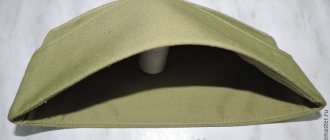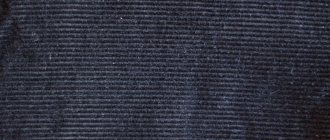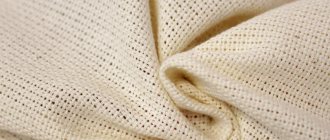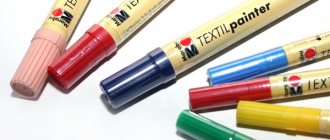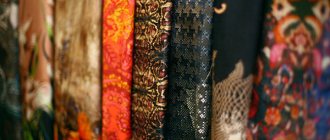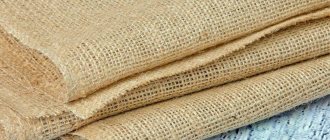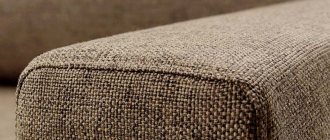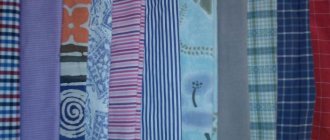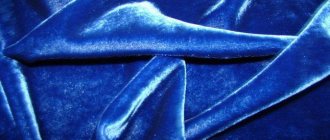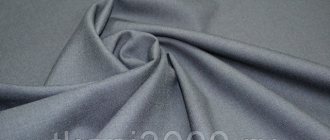How to determine the type of fabric by appearance and touch
If the price tag in a store says “linen,” this does not mean at all that what you see is really linen. It is quite possible that this is pure synthetics, imitating linen. And the inscription “cashmere” does not guarantee the presence of wool in the fabric. Fabric manufacturers have learned to pass off synthetics as linen, viscose as wool... Therefore, as they say, trust, but verify.
The most accurate way to check the type of fiber is by combustion test. But you won’t burn fabric in a store, so it’s important to be able to determine the fibrous composition of the material by appearance, touch, and crush test.
When examining the fabric, pay attention to the thickness, smoothness and shine of the threads, and the rigidity - the plasticity of the fabric. And listen to the sensations that arise when you touch the fabric.
To test for creasing, squeeze the fabric into a fist for 30 seconds, then release and smooth it with your hand. The nature of the folds will help determine the composition of the fabric.
Fabrics made from cotton fibers
Fabrics made from cotton fibers are warm to the touch, slightly rough, and dry. Their touch on the body is comfortable.
Fabrics made from long-staple cotton (such as cotton cambric) are thinner and smoother, so they may have a silky feel, but the silkiness is subtle and not at all like staple fabrics.
Cotton fabrics wrinkle heavily, and after smoothing them with your hand, the folds do not disappear. The addition of synthetics reduces wrinkling.
PS New cotton fabrics often have stiffness, smoothness and even a slight shine due to the sizing applied to them, which is washed off during washing.
Fabrics made from linen fibers
Fabrics made from linen fibers look and feel similar to cotton, but are a little stiffer and cooler.
Linen threads are often uneven in thickness, i.e. have thickenings in certain areas. Also, linen yarn may have a slight shine due to the special faceted shape of the flax fibers.
Linen fabrics do not dye well, so they are characterized by dull colors: blue, light green, pale yellow... If linen fabric is bright in color, then there are additives of other fibers. It is even possible that there is no flax at all.
Linen fabrics wrinkle heavily, the resulting folds are very stable and difficult to smooth out not only with your hand, but also with an iron. Therefore, synthetics are introduced into linen fabrics.
If cotton or viscose is added to linen, the fabric wrinkles just as much, but smoothes out more easily.
Natural silk fabrics
Very pleasant and soft to the touch, have a soft deep shine, not like the harsh shine of fabrics made from chemical fibers.
Fabrics made from crepe silk threads (crepe de Chine) are rough due to a special type of thread twist, the shine is very restrained, but still noticeable.
Thin fabrics made from natural silk are almost weightless and can be threaded through a wedding ring. I checked, I succeeded, although it seemed impossible.
Undyed fabrics in a pleasant creamy shade.
Fabrics made from natural silk do not wrinkle much; the folds gradually disappear when smoothed by hand.
Fabrics made from wool fibers
Fabrics made from wool fibers give a feeling of warmth and scratchiness. It is not always possible to catch the prickliness with your palm, so you can touch the fabric with a more delicate place, for example, the cheek or neck.
Woolen fabrics are woolly, because the tips of wool fibers stick out on the surface. There may be more or less of them depending on the density and weave of the fabric, as well as the type of fiber used (fine, semi-fine, coarse, semi-coarse wool).
Due to the fluffiness of wool yarn, wool fabrics are matte without shine. Shine appears when improperly ironed and intensive wear on places that experience constant friction (elbows, knees...)
On pure wool fabrics, when wrinkled, soft folds form, which disappear when smoothed by hand.
On woolen fabrics with the addition of plant fibers, large raised folds are formed that do not disappear when smoothed by hand.
On woolen fabrics with the addition of synthetics, large layers are formed that disappear when smoothed by hand.
Fabrics made from artificial fibers
Fabrics made from artificial threads feel harsh and cold to the touch. The shine is sharp, cold, synthetic.
Fabrics made from staple yarn are similar in appearance and feel to cotton, but smoother and silkier. They wrinkle very badly, and when smoothed by hand, the folds do not disappear.
Read more about the staple here
Fabrics made from synthetic threads
The modern textile industry is developing and constantly offers new types of fibers, threads, yarns, weaves, and fabric finishing, so fabrics made from synthetic threads are very diverse in appearance. They can be either clearly synthetic or imitate natural ones.
The shine of smooth synthetic fabrics is sharper than that of natural silk.
Synthetic fabrics resist wrinkles well. The resulting wrinkles are smoothed out well.
To the touch, synthetic fabrics seem to be “detached”, i.e. less pleasant and colder than natural ones. But this is sometimes such an elusive nuance that is accessible only to those who work a lot with fabrics.
The only sure way to determine whether a fabric is synthetic or not is to conduct a burn test. When synthetics burn, melting always occurs.
Train your ability to feel fabrics. This is a very useful skill, especially for those who sew, because... allows you to predict the behavior of the fabric during sewing and wearing, and therefore prevent possible troubles.
DO YOU THINK THIS WOULD BE USEFUL FOR YOUR FRIENDS? SHARE WITH THEM ON SOCIAL NETWORKS!
Drawing conclusions
In fact, it’s not so scary that the composition of the fabrics, in addition to natural fibers, includes synthetic ones. The presence of impurities is acceptable, but if they do not exceed 30%. Artificial threads are added to the material according to technology, but the characteristics do not change significantly. The fabric becomes smooth, wrinkles less, clothes made from it are pleasant to wear, and are easy to wash.
Modern synthetic fibers are hygroscopic and breathable; you will not feel discomfort when wearing the product for the season. An example can be given: clothing intended for skiing is made from non-natural materials. At the same time, it breathes, removes moisture, but retains heat. Modern weaving production produces synthetics as a high-tech fabric with excellent consumer properties. But if you still prefer natural fabrics for a number of reasons, ask the seller for a certificate; it will indicate the composition in percentage terms.
Question and answer
Any designer, seamstress and ordinary buyer will agree that the appearance of the finished product and how it will manifest itself when worn has a huge dependence on the type of fabric. Thus, the correct choice of material becomes the key to the success of the final product.
Fabric classifications are distinguished depending on:
- weaving method;
- composition of the material;
- appointments;
- and by the availability of finishing.
Based on what fibers were used in production, fabrics are:
- natural;
- artificial;
- mixed.
Artificial ones contain chemical fibers (polymer threads), natural substances of organic (protein or cellulose) or inorganic origin (Lurex, viscose, glass, acetate, metal). Natural ones can contain fibers of plant (linen, hemp, cotton), animal (wool or silk) and mineral origin. Mixed fabric types usually contain fibers from both groups.
According to color characteristics, fabrics are divided into:
- plain;
- multicolor (this group includes variegated, melange, mulled and printed fabrics).
The texture of the material depends on the weaving method: the presence of shine, surface smoothness, hairiness, as well as density and stretchability. All types of natural fabrics have a good ability to absorb moisture and allow air to pass through.
Cotton
Cotton
is soft and warm to the touch. Wrinkles easily. Absorbs water well, becoming stronger. Can be ironed at maximum iron temperature. If you make a wick from the fibers of cotton fabric and set it on fire, it will burn with a yellow flame. At the same time, you will smell the aroma of burnt paper. The wick gradually smolders, emitting whitish smoke. If you rub between your fingers, you will get ash.
Wool
Wool is pleasant to the touch and practically does not wrinkle. If you light a wool wick, it will quickly burn, leaving a round lump. You can grind it into ash with your fingers. Doesn't smolder. In addition, you will smell the smell of burnt hair. To improve the characteristics of woolen fabrics, synthetic fibers are added to them in small quantities ( up to 10% ). Therefore, when burning wool fiber, black smoke may appear, smell like beans or burnt paper, as well as an influx of black color.
By the way, read this article too: Popular online stores
Man-made fibers
Artificial fibers are obtained from natural raw materials (cellulose) using chemical methods. These are viscose, acetate and triacetate.
- Viscose – has a characteristic “silk” shine, soft to the touch. Not electrified. Like cotton, it wrinkles well and quickly absorbs moisture. The combustion behavior is the same as that of cotton.
- Acetate and triacetate give a black cast. When burning, you can smell vinegar. It smolders, emitting white smoke. The remains of the wick are rolled into a ball. You can knead it with your fingers.
Viscose
Textile
Modern industry produces many different types of fabric. Both natural and synthetic. As you know, in clothes made of natural fabric the skin “breathes” , it is more comfortable and pleasant to walk in it. In such clothes it is easier to endure the heat, and in cold weather it retains our body heat well.
Let's remember our school home economics lessons and find out how to identify natural and synthetic fabric.
Natural fibers are cotton, linen, wool and silk.
